Paper Menu >>
Journal Menu >>
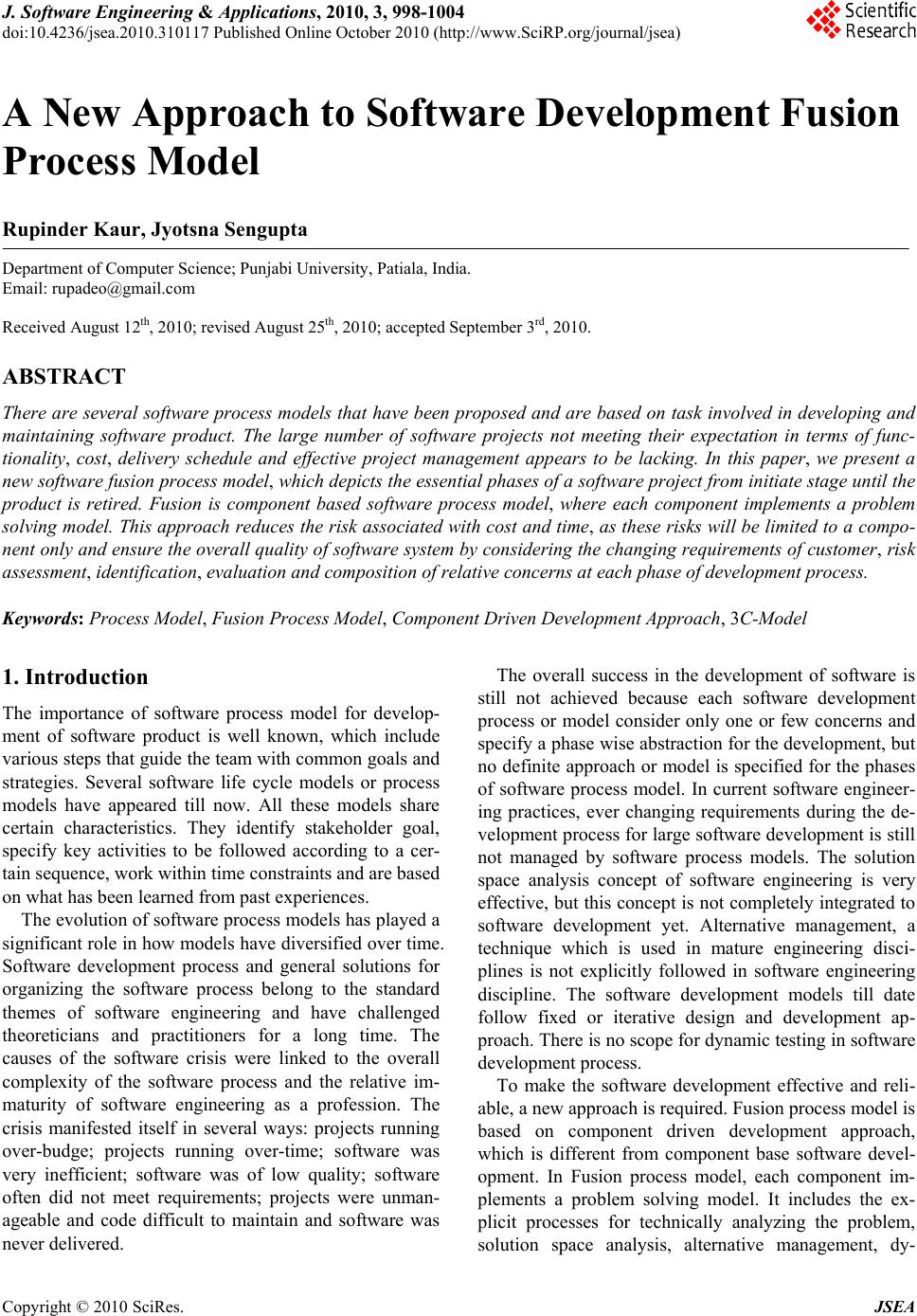 J. Software Engi neeri n g & Applications, 2010, 3, 998-1004 doi:10.4236/jsea.2010.310117 Published Online October 2010 (http://www.SciRP.org/journal/jsea) Copyright © 2010 SciRes. JSEA A New Approach to Software Development Fusion Process Model Rupinder Kaur, Jyotsna Sengupta Department of Computer Science; Punjabi University, Patiala, India. Email: rupadeo@gmail.com Received August 12th, 2010; revised August 25th, 20 1 0 ; accep te d September 3rd, 2010. ABSTRACT There are several software process models that have been proposed and are based on task involved in developing and maintaining software product. The large number of software projects not meeting their expectation in terms of func- tionality, cost, delivery schedule and effective project management appears to be lacking. In this paper, we present a new software fusion process model, which depicts the essential phases of a software project from initiate stage until th e product is retired. Fusion is component based software process model, where each component implements a problem solving model. This approa ch reduces the risk associated with cost and time, as these risks will be limited to a compo- nent only and ensure th e overall quality of software system b y considering the chang ing requirements of custom er, risk assessment, identification, evaluation and composition of relative concerns at each phase of development process. Keywords: Process Model, Fusion Process Model, Component Driven Development Approach, 3C-Model 1. Introduction The importance of software process model for develop- ment of software product is well known, which include various steps that guide the team with common goals and strategies. Several software life cycle models or process models have appeared till now. All these models share certain characteristics. They identify stakeholder goal, specify key activities to be followed according to a cer- tain sequence, work within time constraints and are based on what has been learned from past experiences. The evolution of software process models has played a significant role in how models have diversified over time. Software development process and general solutions for organizing the software process belong to the standard themes of software engineering and have challenged theoreticians and practitioners for a long time. The causes of the software crisis were linked to the overall complexity of the software process and the relative im- maturity of software engineering as a profession. The crisis manifested itself in several ways: projects running over-budge; projects running over-time; software was very inefficient; software was of low quality; software often did not meet requirements; projects were unman- ageable and code difficult to maintain and software was never delive red. The overall success in the development of software is still not achieved because each software development process or model consider only one or few concerns and specify a phase wise abstraction for the development, but no definite approach or model is specified for the phases of software process model. In current software engineer- ing practices, ever changing requirements during the de- velopment process for large software development is still not managed by software process models. The solution space analysis concept of software engineering is very effective, but this concep t is not completely integr ated to software development yet. Alternative management, a technique which is used in mature engineering disci- plines is not explicitly followed in software engineering discipline. The software development models till date follow fixed or iterative design and development ap- proach. There is no scope for dynamic testing in software development process. To make the software development effective and reli- able, a new approach is required. Fusion process model is based on component driven development approach, which is different from component base software devel- opment. In Fusion process model, each component im- plements a problem solving model. It includes the ex- plicit processes for technically analyzing the problem, solution space analysis, alternative management, dy- 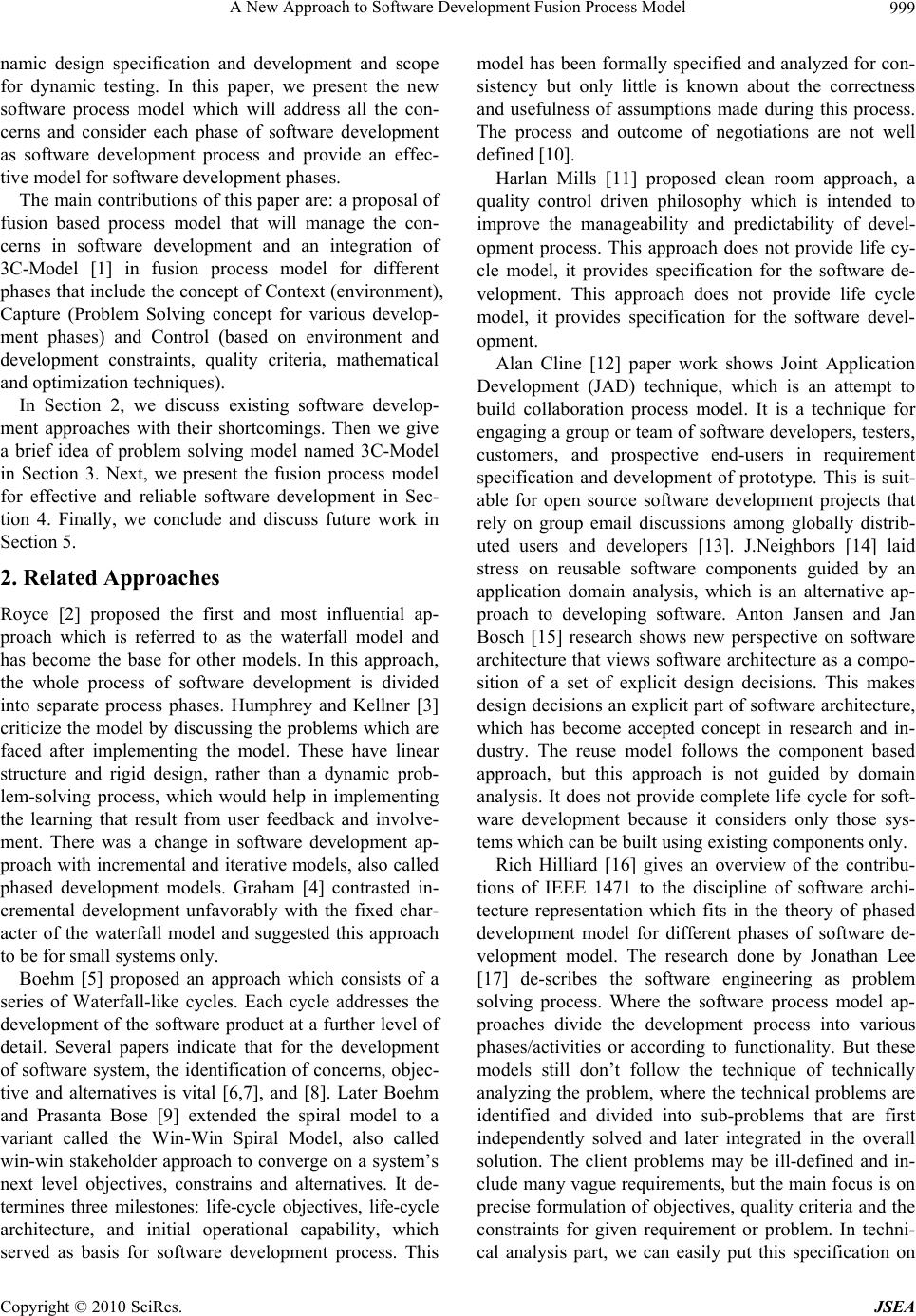 A New Approach to Software Development Fusion Process Model999 namic design specification and development and scope for dynamic testing. In this paper, we present the new software process model which will address all the con- cerns and consider each phase of software development as software development process and provide an effec- tive model for software development phases. The main contributions of this paper are: a proposal of fusion based process model that will manage the con- cerns in software development and an integration of 3C-Model [1] in fusion process model for different phases that include the concept of Context (environment), Capture (Problem Solving concept for various develop- ment phases) and Control (based on environment and development constraints, quality criteria, mathematical and optimization techniques). In Section 2, we discuss existing software develop- ment approaches with their shortcomings. Then we give a brief idea of problem solving model named 3C-Model in Section 3. Next, we present the fusion process model for effective and reliable software development in Sec- tion 4. Finally, we conclude and discuss future work in Section 5. 2. Related Approaches Royce [2] proposed the first and most influential ap- proach which is referred to as the waterfall model and has become the base for other models. In this approach, the whole process of software development is divided into separate process phases. Humphrey and Kellner [3] criticize the model by discussing the problems which are faced after implementing the model. These have linear structure and rigid design, rather than a dynamic prob- lem-solving process, which would help in implementing the learning that result from user feedback and involve- ment. There was a change in software development ap- proach with incremental and iterative models, also called phased development models. Graham [4] contrasted in- cremental development unfavorably with the fixed char- acter of the waterfall model and suggested this approach to be for small systems only. Boehm [5] proposed an approach which consists of a series of Waterfall-like cycles. Each cycle addresses the development of the software product at a further level of detail. Several papers indicate that for the development of software system, the identification of concerns, objec- tive and alternatives is vital [6,7], and [8]. Later Boehm and Prasanta Bose [9] extended the spiral model to a variant called the Win-Win Spiral Model, also called win-win stakeholder approach to converge on a system’s next level objectives, constrains and alternatives. It de- termines three milestones: life-cycle objectives, life-cycle architecture, and initial operational capability, which served as basis for software development process. This model has been formally specified and analyzed for con- sistency but only little is known about the correctness and usefulness of assumptions made during this process. The process and outcome of negotiations are not well defined [10]. Harlan Mills [11] proposed clean room approach, a quality control driven philosophy which is intended to improve the manageability and predictability of devel- opment process. This approach does not provide life cy- cle model, it provides specification for the software de- velopment. This approach does not provide life cycle model, it provides specification for the software devel- opment. Alan Cline [12] paper work shows Joint Application Development (JAD) technique, which is an attempt to build collaboration process model. It is a technique for engaging a group or team of software developers, testers, customers, and prospective end-users in requirement specification and development of prototype. This is suit- able for open source software development projects that rely on group email discussions among globally distrib- uted users and developers [13]. J.Neighbors [14] laid stress on reusable software components guided by an application domain analysis, which is an alternative ap- proach to developing software. Anton Jansen and Jan Bosch [15] research shows new perspective on software architecture that views software architecture as a compo- sition of a set of explicit design decisions. This makes design decisions an explicit part of software architecture, which has become accepted concept in research and in- dustry. The reuse model follows the component based approach, but this approach is not guided by domain analysis. It does not provide complete life cycle for soft- ware development because it considers only those sys- tems which can be built using existing components only. Rich Hilliard [16] gives an overview of the contribu- tions of IEEE 1471 to the discipline of software archi- tecture representation which fits in the theory of phased development model for different phases of software de- velopment model. The research done by Jonathan Lee [17] de-scribes the software engineering as problem solving process. Where the software process model ap- proaches divide the development process into various phases/activities or according to functionality. But these models still don’t follow the technique of technically analyzing the problem, where the technical problems are identified and divided into sub-problems that are first independently solved and later integrated in the overall solution. The client problems may be ill-defined and in- clude many vague requirements, but the main focu s is on precise formulation of ob jectives, quality criteria and the constraints for given requirement or problem. In techni- cal analysis part, we can easily put this specification on Copyright © 2010 SciRes. JSEA 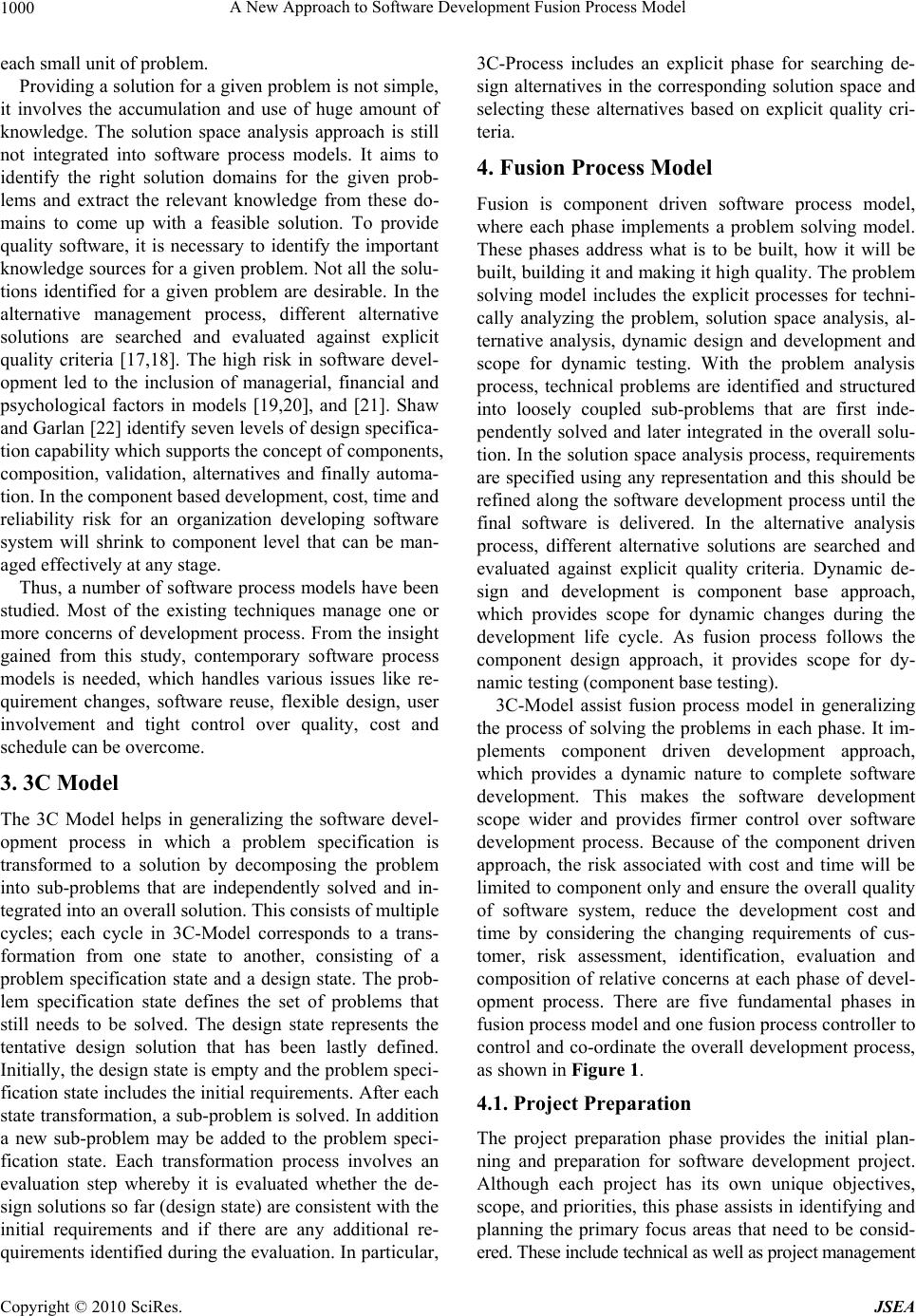 A New Approach to Software Development Fusion Process Model 1000 each small unit of problem. Providing a solution for a given problem is not simple, it involves the accumulation and use of huge amount of knowledge. The solution space analysis approach is still not integrated into software process models. It aims to identify the right solution domains for the given prob- lems and extract the relevant knowledge from these do- mains to come up with a feasible solution. To provide quality software, it is necessary to identify the important knowledge sources for a given prob lem. Not all the solu- tions identified for a given problem are desirable. In the alternative management process, different alternative solutions are searched and evaluated against explicit quality criteria [17,18]. The high risk in software devel- opment led to the inclusion of managerial, financial and psychological factors in models [19,20], and [21]. Shaw and Garlan [22] identify seven levels of design specifica- tion capability which supports the concept of components, composition, validation, alternatives and finally automa- tion. In the component based development, cost, time and reliability risk for an organization developing software system will shrink to component level that can be man- aged effectively at any stage. Thus, a number of software process models have been studied. Most of the existing techniques manage one or more concerns of development process. From the insight gained from this study, contemporary software process models is needed, which handles various issues like re- quirement changes, software reuse, flexible design, user involvement and tight control over quality, cost and schedule can be overcome. 3. 3C Model The 3C Model helps in generalizing the software devel- opment process in which a problem specification is transformed to a solution by decomposing the problem into sub-problems that are independently solved and in- tegrated into an overall solution. This consists of multiple cycles; each cycle in 3C-Model corresponds to a trans- formation from one state to another, consisting of a problem specification state and a design state. The prob- lem specification state defines the set of problems that still needs to be solved. The design state represents the tentative design solution that has been lastly defined. Initially, the design state is empty and the problem speci- fication state includes the initial requirements. After each state transformation, a sub-problem is solved. In additio n a new sub-problem may be added to the problem speci- fication state. Each transformation process involves an evaluation step whereby it is evaluated whether the de- sign solution s so far (design state) are consistent with the initial requirements and if there are any additional re- quirements identified during the evaluation. In particular, 3C-Process includes an explicit phase for searching de- sign alternatives in the corresponding solution space and selecting these alternatives based on explicit quality cri- teria. 4. Fusion Process Model Fusion is component driven software process model, where each phase implements a problem solving model. These phases address what is to be built, how it will be built, building it and making it high quality. The prob lem solving model includes the explicit processes for techni- cally analyzing the problem, solution space analysis, al- ternative analysis, dynamic design and development and scope for dynamic testing. With the problem analysis process, technical problems are identified and structured into loosely coupled sub-problems that are first inde- pendently solved and later integrated in the overall solu- tion. In the solution space analysis process, requirements are specified using any representation and this should be refined along the software development process until the final software is delivered. In the alternative analysis process, different alternative solutions are searched and evaluated against explicit quality criteria. Dynamic de- sign and development is component base approach, which provides scope for dynamic changes during the development life cycle. As fusion process follows the component design approach, it provides scope for dy- namic testing (component base testing). 3C-Model assist fusion process model in generalizing the process of solving the problems in each phase. It im- plements component driven development approach, which provides a dynamic nature to complete software development. This makes the software development scope wider and provides firmer control over software development process. Because of the component driven approach, the risk associated with cost and time will be limited to component only and ensure the overall quality of software system, reduce the development cost and time by considering the changing requirements of cus- tomer, risk assessment, identification, evaluation and composition of relative concerns at each phase of devel- opment process. There are five fundamental phases in fusion process model and one fusion process controller to control and co-ordinate the overall development process, as shown in Figure 1. 4.1. Project Preparation The project preparation phase provides the initial plan- ning and preparation for software development project. Although each project has its own unique objectives, scope, and priorities, this phase assists in identifying and planning the primary focus areas that need to be consid- ered. These include tech nical as well as project m anagem ent Copyright © 2010 SciRes. JSEA 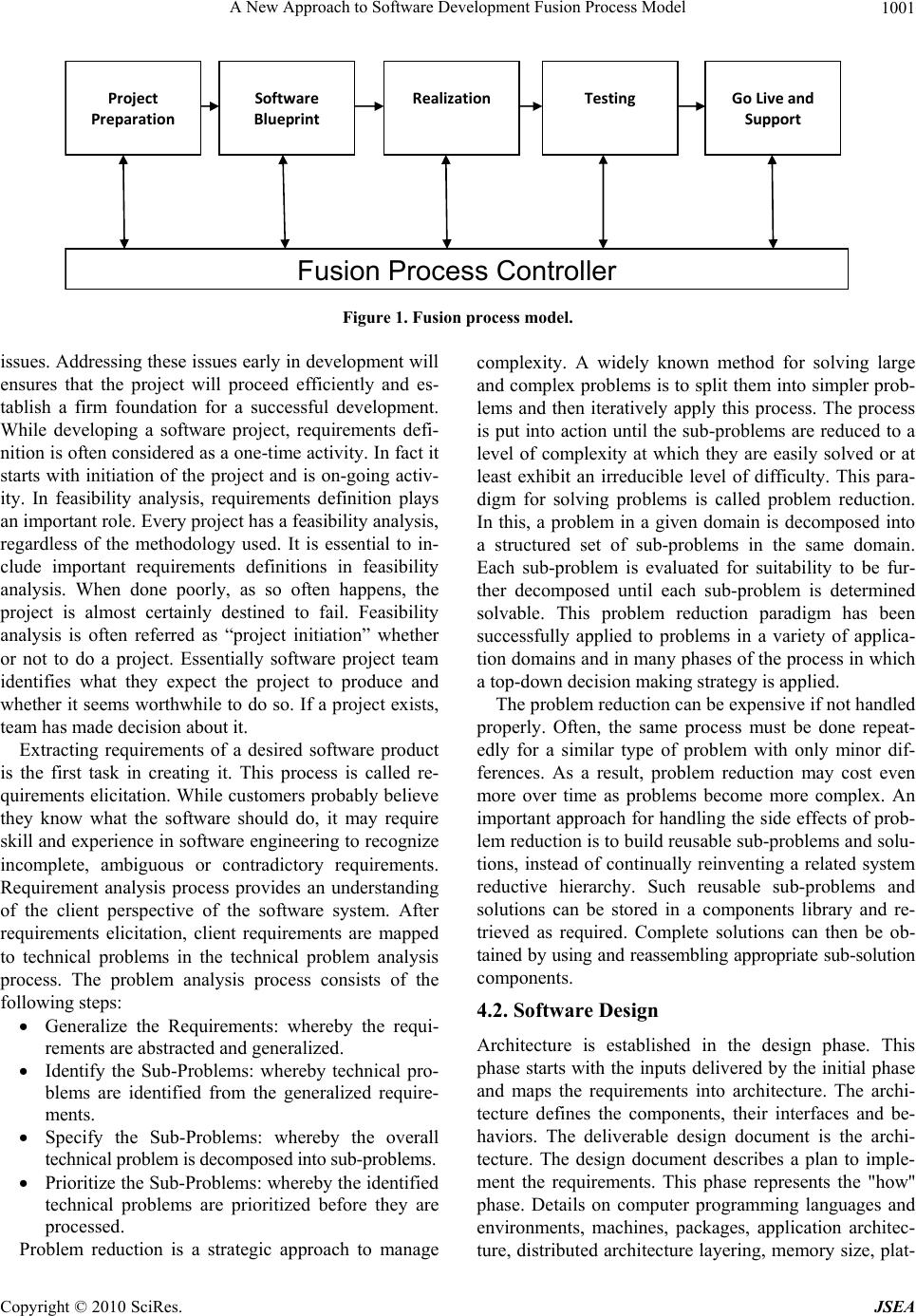 A New Approach to Software Development Fusion Process Model Copyright © 2010 SciRes. JSEA 1001 Project Preparati on Fusion Process Controller Soft w ar e Blueprint RealizationTesting GoLiveand Support Figure 1. Fusion process model. issues. Addressing these issues early in development will ensures that the project will proceed efficiently and es- tablish a firm foundation for a successful development. While developing a software project, requirements defi- nition is often considered as a one-time activity. In fact it starts with initiation of the project and is on-going activ- ity. In feasibility analysis, requirements definition plays an important role. Every project has a feasibility analysis, regardless of the methodology used. It is essential to in- clude important requirements definitions in feasibility analysis. When done poorly, as so often happens, the project is almost certainly destined to fail. Feasibility analysis is often referred as “project initiation” whether or not to do a project. Essentially software project team identifies what they expect the project to produce and whether it seems worthwhile to do so. If a project ex ists, team has made decision about it. Extracting requirements of a desired software product is the first task in creating it. This process is called re- quirements elicitation. While customers probably believe they know what the software should do, it may require skill and experience in so ftware engineering to recognize incomplete, ambiguous or contradictory requirements. Requirement analysis process provides an understanding of the client perspective of the software system. After requirements elicitation, client requirements are mapped to technical problems in the technical problem analysis process. The problem analysis process consists of the following steps: Generalize the Requirements: whereby the requi- rements are abstracted and generalized. Identify the Sub-Problems: whereby technical pro- blems are identified from the generalized require- ments. Specify the Sub-Problems: whereby the overall technical problem is decom posed into sub-probl em s. Prioritize the Sub-Problems: whereby th e identified technical problems are prioritized before they are processed. Problem reduction is a strategic approach to manage complexity. A widely known method for solving large and complex problems is to sp lit them into simpler prob- lems and then iteratively apply this process. The process is put into action until the sub-problems are reduced to a level of complexity at which they are easily solved or at least exhibit an irreducible level of difficulty. This para- digm for solving problems is called problem reduction. In this, a problem in a given domain is decomposed into a structured set of sub-problems in the same domain. Each sub-problem is evaluated for suitability to be fur- ther decomposed until each sub-problem is determined solvable. This problem reduction paradigm has been successfully applied to problems in a variety of applica- tion domains and in many phases of the process in which a top-down decision making strategy is applied. The problem reduction can be expensive if not handled properly. Often, the same process must be done repeat- edly for a similar type of problem with only minor dif- ferences. As a result, problem reduction may cost even more over time as problems become more complex. An important approach for handling the side effects of prob- lem reduction is to build reus able sub-problems and solu- tions, instead of continually reinventing a related system reductive hierarchy. Such reusable sub-problems and solutions can be stored in a components library and re- trieved as required. Complete solutions can then be ob- tained by using and reassembling appropriate sub-solution components. 4.2. Software Design Architecture is established in the design phase. This phase starts with the inputs delivered by the initial phase and maps the requirements into architecture. The archi- tecture defines the components, their interfaces and be- haviors. The deliverable design document is the archi- tecture. The design document describes a plan to imple- ment the requirements. This phase represents the "how'' phase. Details on computer programming languages and environments, machines, packages, application architec- ture, distributed architecture layering, memory size, plat- 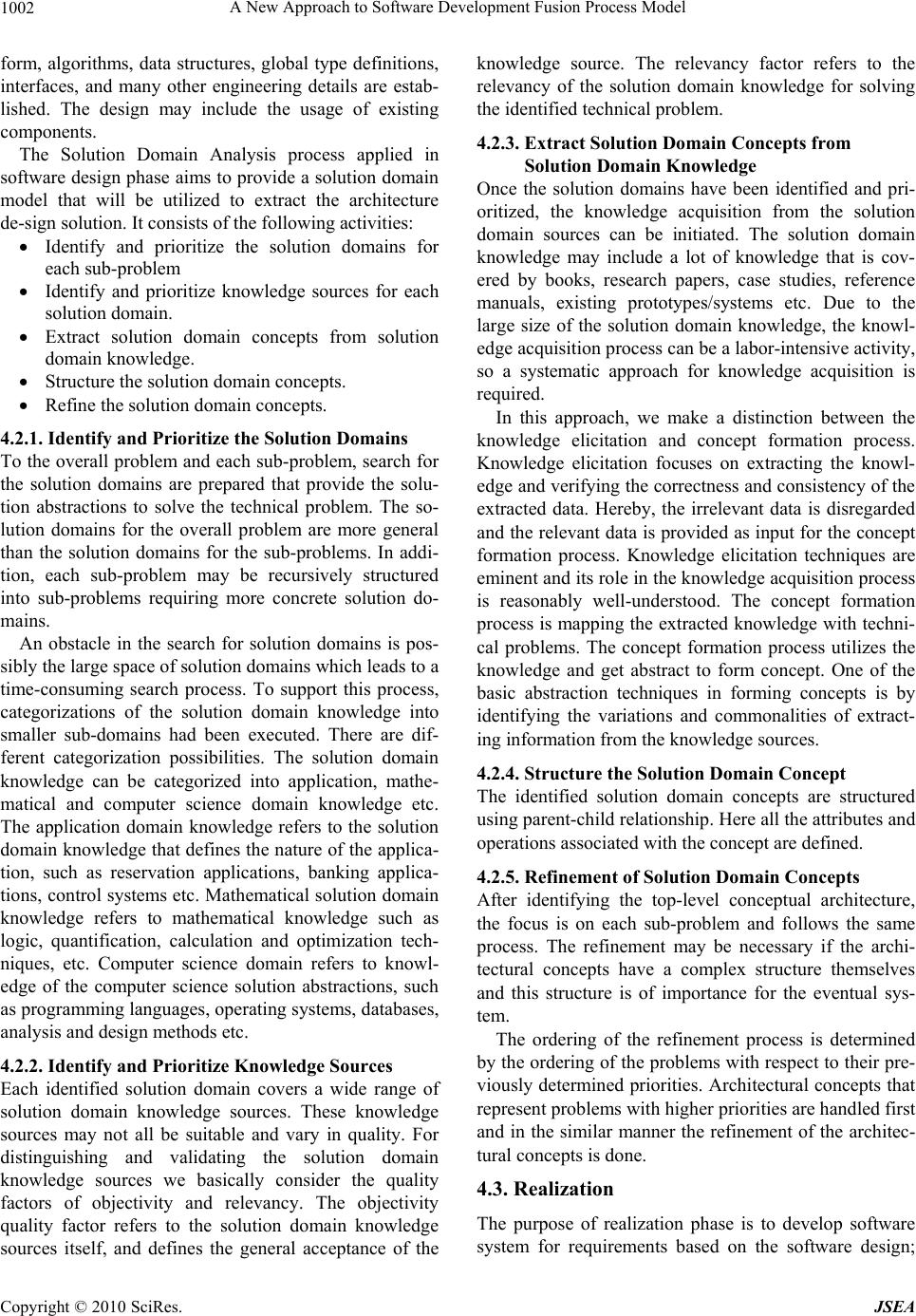 A New Approach to Software Development Fusion Process Model 1002 form, algorithms, data structures, global type definitions, interfaces, and many other engineering details are estab- lished. The design may include the usage of existing components. The Solution Domain Analysis process applied in software design phase aims to provide a solution domain model that will be utilized to extract the architecture de-sign solution. It consists of the following activities: Identify and prioritize the solution domains for each sub-problem Identify and prioritize knowledge sources for each solution domain. Extract solution domain concepts from solution domain knowledge. Structure the solution domain concepts. Refine the solution domain concepts. 4.2.1. Identify and Prioritize the Solution Domains To the overall problem and each sub-problem, search for the solution domains are prepared that provide the solu- tion abstractions to solve the technical problem. The so- lution domains for the overall problem are more general than the solution domains for the sub-problems. In addi- tion, each sub-problem may be recursively structured into sub-problems requiring more concrete solution do- mains. An obstacle in the search for solution domains is pos- sibly the large space of solution domains which leads to a time-consuming search process. To support this process, categorizations of the solution domain knowledge into smaller sub-domains had been executed. There are dif- ferent categorization possibilities. The solution domain knowledge can be categorized into application, mathe- matical and computer science domain knowledge etc. The application domain knowledge refers to the solution domain knowledge that defines the nature of the applica- tion, such as reservation applications, banking applica- tions, control syste ms etc. Mathematical solutio n domain knowledge refers to mathematical knowledge such as logic, quantification, calculation and optimization tech- niques, etc. Computer science domain refers to knowl- edge of the computer science solution abstractions, such as programming languages, operating systems, databases, analysis and design methods etc. 4.2.2. Identify and Prioritize Knowledge Sources Each identified solution domain covers a wide range of solution domain knowledge sources. These knowledge sources may not all be suitable and vary in quality. For distinguishing and validating the solution domain knowledge sources we basically consider the quality factors of objectivity and relevancy. The objectivity quality factor refers to the solution domain knowledge sources itself, and defines the general acceptance of the knowledge source. The relevancy factor refers to the relevancy of the solution domain knowledge for solving the identified technical prob lem. 4.2.3. Extract Solution Domain Concepts from Solution Domain Knowledge Once the solution domains have been identified and pri- oritized, the knowledge acquisition from the solution domain sources can be initiated. The solution domain knowledge may include a lot of knowledge that is cov- ered by books, research papers, case studies, reference manuals, existing prototypes/systems etc. Due to the large size of the solution domain knowledge, the knowl- edge acquisition process can be a labor-intensive activity, so a systematic approach for knowledge acquisition is required. In this approach, we make a distinction between the knowledge elicitation and concept formation process. Knowledge elicitation focuses on extracting the knowl- edge and verifying the correctness and consistency of the extracted data. Hereby, the irrelevant data is disregarded and the relevant data is provided as input for the concept formation process. Knowledge elicitation techniques are eminent and its role in the know ledge acquisition process is reasonably well-understood. The concept formation process is mapping the ex tracted knowledge with techni- cal problems. The concept formation process utilizes the knowledge and get abstract to form concept. One of the basic abstraction techniques in forming concepts is by identifying the variations and commonalities of extract- ing information from the knowledge sources. 4.2.4. Structure the Solution Domain Concept The identified solution domain concepts are structured using parent-child relationship . Here all the attribu tes and operations associated with the concept are defined. 4.2.5. Refi nement of Soluti o n Domain Concepts After identifying the top-level conceptual architecture, the focus is on each sub-problem and follows the same process. The refinement may be necessary if the archi- tectural concepts have a complex structure themselves and this structure is of importance for the eventual sys- tem. The ordering of the refinement process is determined by the ordering of the problems with respect to th eir pre- viously determined priorities. Architectural concepts that represent problems with higher priorities are handled first and in the similar manner the refinement of the architec- tural concepts is done. 4.3. Realization The purpose of realization phase is to develop software system for requirements based on the software design; Copyright © 2010 SciRes. JSEA 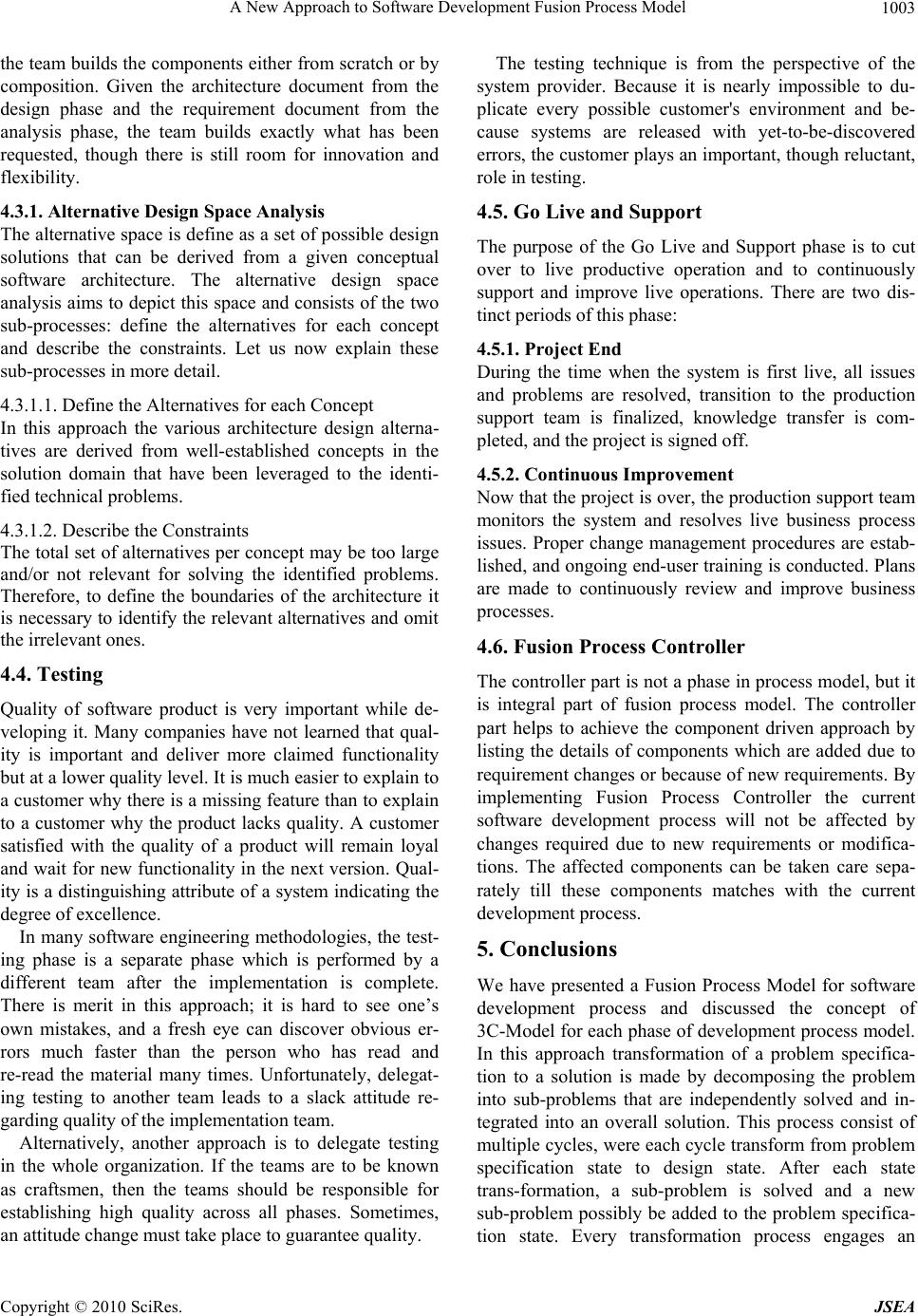 A New Approach to Software Development Fusion Process Model1003 the team builds the components either from scratch or by composition. Given the architecture document from the design phase and the requirement document from the analysis phase, the team builds exactly what has been requested, though there is still room for innovation and flexibility. 4.3.1. Alternative Design Space Analysis The alternative space is define as a set of possible design solutions that can be derived from a given conceptual software architecture. The alternative design space analysis aims to depict this space and consists of the two sub-processes: define the alternatives for each concept and describe the constraints. Let us now explain these sub-processes in more detail. 4.3.1.1. Defin e the Alternatives for each Concept In this approach the various architecture design alterna- tives are derived from well-established concepts in the solution domain that have been leveraged to the identi- fied technical problems. 4.3.1.2. Describe the Constraints The total set of alternatives per con cept may be too large and/or not relevant for solving the identified problems. Therefore, to define the boundaries of the architecture it is necessary to identify the relevan t alternatives and omit the irrelevant ones. 4.4. Testing Quality of software product is very important while de- veloping it. Many companies have not learned that qual- ity is important and deliver more claimed functionality but at a lower quality level. It is much easier to ex plain to a customer why there is a missing feature than to explain to a customer why the product lacks quality. A customer satisfied with the quality of a product will remain loyal and wait for new functionality in the next version. Qual- ity is a distinguishing attribute of a system indicating the degree of excellence. In many software engineering methodologies, the test- ing phase is a separate phase which is performed by a different team after the implementation is complete. There is merit in this approach; it is hard to see one’s own mistakes, and a fresh eye can discover obvious er- rors much faster than the person who has read and re-read the material many times. Unfortunately, delegat- ing testing to another team leads to a slack attitude re- garding quality of th e implementation team. Alternatively, another approach is to delegate testing in the whole organization. If the teams are to be known as craftsmen, then the teams should be responsible for establishing high quality across all phases. Sometimes, an attitude change must take place to guarantee quality. The testing technique is from the perspective of the system provider. Because it is nearly impossible to du- plicate every possible customer's environment and be- cause systems are released with yet-to-be-discovered errors, the customer plays an important, though reluctant, role in testing. 4.5. Go Live and Support The purpose of the Go Live and Support phase is to cut over to live productive operation and to continuously support and improve live operations. There are two dis- tinct periods of this phase: 4.5.1. Project E nd During the time when the system is first live, all issues and problems are resolved, transition to the production support team is finalized, knowledge transfer is com- pleted, and the project is signed off. 4.5.2. Contin uous Improvement Now that the project is over, the production support team monitors the system and resolves live business process issues. Proper change management procedures are estab- lished, and ongoing end-user training is conducted. Plans are made to continuously review and improve business processes. 4.6. Fusion Process Controller The controller part is not a phase in process model, but it is integral part of fusion process model. The controller part helps to achieve the component driven approach by listing the details of components which are added due to requirement changes or because of new requirements. By implementing Fusion Process Controller the current software development process will not be affected by changes required due to new requirements or modifica- tions. The affected components can be taken care sepa- rately till these components matches with the current development process. 5. Conclusions We have presented a Fusion Process Model for software development process and discussed the concept of 3C-Model for each phase of development process model. In this approach transformation of a problem specifica- tion to a solution is made by decomposing the problem into sub-problems that are independently solved and in- tegrated into an overall solution. This process consist of multiple cycles, were each cycle transform from problem specification state to design state. After each state trans-formation, a sub-problem is solved and a new sub-problem possibly be added to the problem specifica- tion state. Every transformation process engages an Copyright © 2010 SciRes. JSEA 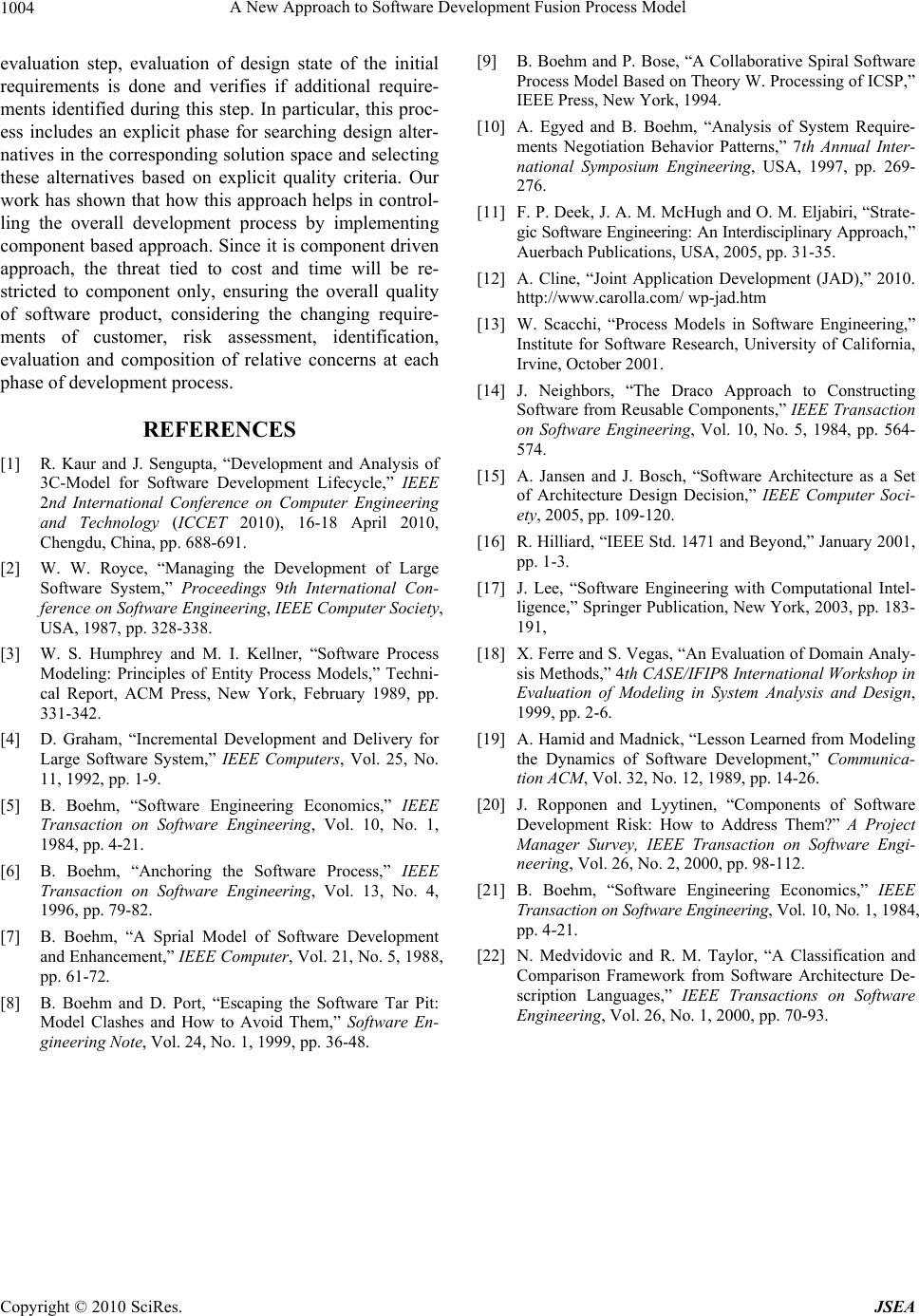 A New Approach to Software Development Fusion Process Model Copyright © 2010 SciRes. JSEA 1004 evaluation step, evaluation of design state of the initial requirements is done and verifies if additional require- ments identified during this step. In particular, this proc- ess includes an explicit phase for searching design alter- natives in the corresponding solution space and selecting these alternatives based on explicit quality criteria. Our work has shown that how this approach helps in control- ling the overall development process by implementing component based approach. Since it is component driven approach, the threat tied to cost and time will be re- stricted to component only, ensuring the overall quality of software product, considering the changing require- ments of customer, risk assessment, identification, evaluation and composition of relative concerns at each phase of development process. REFERENCES [1] R. Kaur and J. Sengupta, “Development and Analysis of 3C-Model for Software Development Lifecycle,” IEEE 2nd International Conference on Computer Engineering and Technology (ICCET 2010), 16-18 April 2010, Chengdu, China, pp. 688-691. [2] W. W. Royce, “Managing the Development of Large Software System,” Proceedings 9th International Con- ference on Software Engineering, IEEE Computer Society, USA, 1987, pp. 328-338. [3] W. S. Humphrey and M. I. Kellner, “Software Process Modeling: Principles of Entity Process Models,” Techni- cal Report, ACM Press, New York, February 1989, pp. 331-342. [4] D. Graham, “Incremental Development and Delivery for Large Software System,” IEEE Computers, Vol. 25, No. 11, 1992, pp. 1-9. [5] B. Boehm, “Software Engineering Economics,” IEEE Transaction on Software Engineering, Vol. 10, No. 1, 1984, pp. 4-21. [6] B. Boehm, “Anchoring the Software Process,” IEEE Transaction on Software Engineering, Vol. 13, No. 4, 1996, pp. 79-82. [7] B. Boehm, “A Sprial Model of Software Development and Enhancement,” IEEE Computer, Vol. 21, No. 5, 1988, pp. 61-72. [8] B. Boehm and D. Port, “Escaping the Software Tar Pit: Model Clashes and How to Avoid Them,” Software En- gineering Note, Vol. 24, No. 1, 1999, pp. 36-48. [9] B. Boehm and P. Bose, “A Collaborative Spiral Software Process Model Based on Theory W. Processing of ICSP,” IEEE Press, New York, 1994. [10] A. Egyed and B. Boehm, “Analysis of System Require- ments Negotiation Behavior Patterns,” 7th Annual Inter- national Symposium Engineering, USA, 1997, pp. 269- 276. [11] F. P. Deek, J. A. M. McHugh and O. M. Eljabiri, “Strate- gic Software Engineering: An Int erdisciplinary App r oa ch ,” Auerbach Publications, USA, 2005, pp. 31-35. [12] A. Cline, “Joint Application Development (JAD),” 2010. http://www.carolla.com/ wp-jad.htm [13] W. Scacchi, “Process Models in Software Engineering,” Institute for Software Research, University of California, Irvine, October 2001. [14] J. Neighbors, “The Draco Approach to Constructing Software from Reusable Components,” IEEE Transaction on Software Engineering, Vol. 10, No. 5, 1984, pp. 564- 574. [15] A. Jansen and J. Bosch, “Software Architecture as a Set of Architecture Design Decision,” IEEE Computer Soci- ety, 2005, pp. 109-120. [16] R. Hilliard, “IEEE Std. 1471 and Beyond,” January 2001, pp. 1-3. [17] J. Lee, “Software Engineering with Computational Intel- ligence,” Springer Publication, New York, 2003, pp. 183- 191, [18] X. Ferre and S. Vegas, “An Evaluation of Domain Analy- sis Methods,” 4th CASE/IFIP8 International Workshop in Evaluation of Modeling in System Analysis and Design, 1999, pp. 2-6. [19] A. Hamid and Madnick, “Lesson Learned from Modeling the Dynamics of Software Development,” Communica- tion ACM, Vol. 32, No. 12, 1989, pp. 14-26. [20] J. Ropponen and Lyytinen, “Components of Software Development Risk: How to Address Them?” A Project Manager Survey, IEEE Transaction on Software Engi- neering, Vol. 26, No. 2, 2000, pp. 98-112. [21] B. Boehm, “Software Engineering Economics,” IEEE Transaction on Software Engineer ing, Vol. 10, No. 1, 1984, pp. 4-21. [22] N. Medvidovic and R. M. Taylor, “A Classification and Comparison Framework from Software Architecture De- scription Languages,” IEEE Transactions on Software Engineering, Vol. 26, No. 1, 2000, pp. 70-93. |

